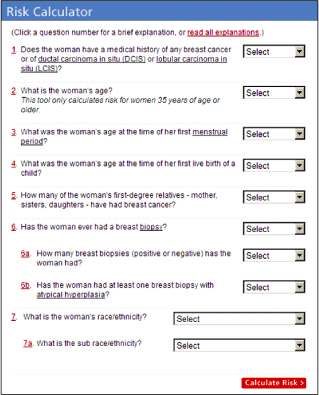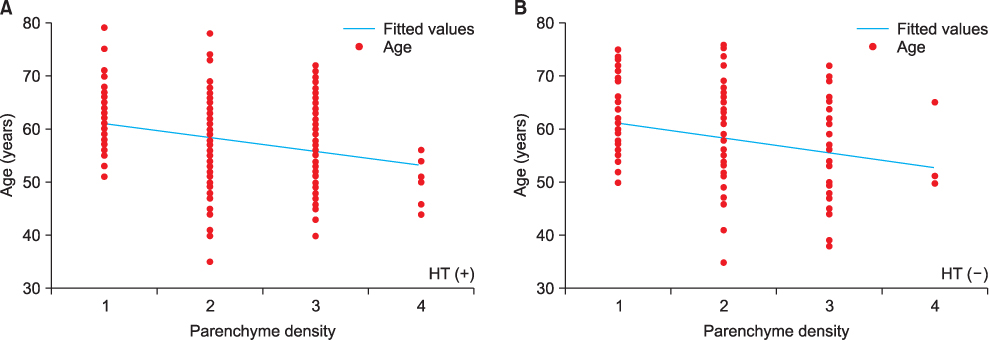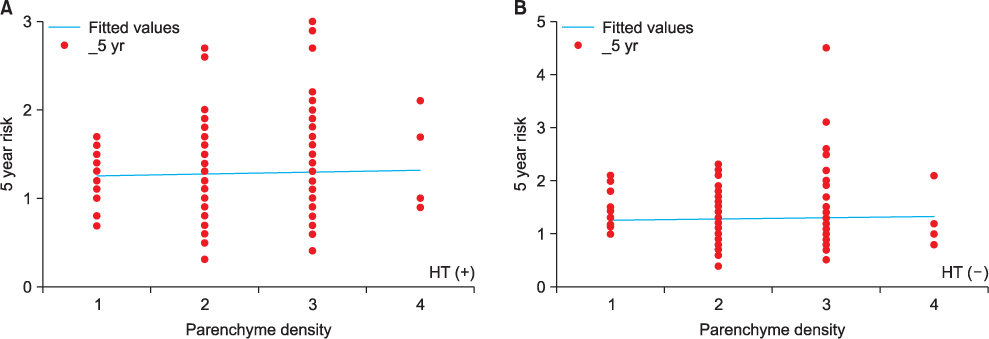J Korean Soc Menopause.
2012 Dec;18(3):180-186.
Estimation of the Relative Risk for Breast Cancer in Korean Women Using Gail Model
- Affiliations
-
- 1Department of Obstetrics and Gynecology, Soonchunhyang University Seoul Hospital, Soonchunhyang University College of Medicine, Seoul, Korea.
- 2Department of Preventive Medicine, Chung-Ang University College of Medicine, Seoul, Korea.
- 3Department of Radiology, Chung-Ang University Hospital, Chung-Ang University College of Medicine, Seoul, Korea.
- 4Department of Obstetrics and Gynecology, Chung-Ang University Hospital, Chung-Ang University College of Medicine, Seoul, Korea. hmpark52@hanmail.net
Abstract
OBJECTIVES
The aim of this study is to estimate the relative risk for breast cancer using the Gail model and to observe the relationship between mammographic density and the 5-year risk of breast cancer.
METHODS
A total of 600 women who visited the Department of Obstetrics and Gynecology in Chung-Ang University Yongsan Hospital were screened using the Gail model to estimate their relative risk for breast cancer. The correlation between the 5-year risk of breast cancer and the mammographic density of 462 women who had performed mammography within 1 year of the study was analyzed.
RESULTS
The mean age of the study subjects was 56.7 +/- 8.2 years. The estimated mean values for the 5-year risk and lifetime risk for breast cancer were 1.23 +/- 0.46% and 7.90 +/- 2.76% respectively in all study subjects. The estimated mean value of the 5-year risk for breast cancer increased with age. Otherwise, the estimated lifetime risk for breast cancer decreased with age. Ninety-two women (15.3%) were classified as high-risk because their estimated 5-year risk was over 1.67% or their lifetime risk was over 20%. High risk percentages according to age were 10.5% in the thirties, 0.84% in the forties, 7.2% in the fifties, 32.7% in the sixties, and 35.7% in the seventies. Among the high risk postmenopausal women, 52.2% were taking hormone therapy. Mammographic density was not significantly correlated with the estimated 5-year risk for breast cancer.
CONCLUSION
About fifteen percent of study subjects were at high risk for breast cancer according to the estimated 5-year risk or lifetime risk for breast cancer using Gail model. Mammographic density was not correlated with the 5-year risk for breast cancer.
Keyword
MeSH Terms
Figure
Reference
-
1. International Agency for Research on Cancer. GLOBOCAN 2008. 2008. cited by 2010 Sep. Lyon: IARC;Available from: http://globocan.iarc.fr.2. Jung YS, Na KY, Kim KS, Ahn SH, Lee SJ, Park HK, et al. Nation-wide Korean breast cancer data from 2008 using the breast cancer registration program. J Breast Cancer. 2011. 14:229–236.3. Son BH, Kwak BS, Kim JK, Kim HJ, Hong SJ, Lee JS, et al. Changing patterns in the clinical characteristics of Korean patients with breast cancer during the last 15 years. Arch Surg. 2006. 141:155–160.4. Chang MC. Estimating relative risk of breast cancer in Korean women using computer program. J Korean Breast Cancer Soc. 2004. 7:294–298.5. Euhus DM. Understanding mathematical models for breast cancer risk assessment and counseling. Breast J. 2001. 7:224–232.6. Fisher B, Costantino JP, Wickerham DL, Redmond CK, Kavanah M, Cronin WM, et al. Tamoxifen for prevention of breast cancer: report of the national surgical adjuvant breast and bowel project P-1 study. J Natl Cancer Inst. 1998. 90:1371–1388.7. Dunn BK, Ford LG. From adjuvant therapy to breast cancer prevention: BCPT and STAR. Breast J. 2001. 7:144–157.8. Gail MH, Brinton LA, Byar DP, Corle DK, Green SB, Schairer C, et al. Projecting individualized probabilities of developing breast cancer for white females who are being examined annually. J Natl Cancer Inst. 1989. 81:1879–1886.9. Evans DG, Howell A. Breast cancer risk-assessment models. Breast Cancer Res. 2007. 9:213.10. Steinberg KK, Thacker SB, Smith SJ, Stroup DF, Zack MM, Flanders WD, et al. A meta-analysis of the effect of estrogen replacement therapy on the risk of breast cancer. JAMA. 1991. 265:1985–1990.11. Harvie M, Hooper L, Howell AH. Central obesity and breast cancer risk: a systematic review. Obes Rev. 2003. 4:157–173.12. Mitchell G, Antoniou AC, Warren R, Peock S, Brown J, Davies R, et al. Mammographic density and breast cancer risk in BRCA1 and BRCA2 mutation carriers. Cancer Res. 2006. 66:1866–1872.13. Amir E, Evans DG, Shenton A, Lalloo F, Moran A, Boggis C, et al. Evaluation of breast cancer risk assessment packages in the family history evaluation and screening programme. J Med Genet. 2003. 40:807–814.14. McCormack VA, dos Santos Silva I. Breast density and parenchymal patterns as markers of breast cancer risk: a meta-analysis. Cancer Epidemiol Biomarkers Prev. 2006. 15:1159–1169.15. Kato I, Beinart C, Bleich A, Su S, Kim M, Toniolo PG. A nested case-control study of mammographic patterns, breast volume, and breast cancer (New York City, NY, United States). Cancer Causes Control. 1995. 6:431–438.16. Saftlas AF, Hoover RN, Brinton LA, Szklo M, Olson DR, Salane M, et al. Mammographic densities and risk of breast cancer. Cancer. 1991. 67:2833–2838.17. Byrne C, Schairer C, Wolfe J, Parekh N, Salane M, Brinton LA, et al. Mammographic features and breast cancer risk: effects with time, age, and menopause status. J Natl Cancer Inst. 1995. 87:1622–1629.18. Torres-Mejía G, De Stavola B, Allen DS, Pérez-Gavilán JJ, Ferreira JM, Fentiman IS, et al. Mammographic features and subsequent risk of breast cancer: a comparison of qualitative and quantitative evaluations in the Guernsey prospective studies. Cancer Epidemiol Biomarkers Prev. 2005. 14:1052–1059.19. Boyd NF, Martin LJ, Yaffe MJ, Minkin S. Mammographic density and breast cancer risk: current understanding and future prospects. Breast Cancer Res. 2011. 13:223.20. Wee CW, Kang M, Seo KY, Choe YH, Min YK, Lee DY, et al. Impact of oral levonorgestrel for 1 year on mammographic density in menopausal hormone therapy. J Korean Soc Menopause. 2011. 17:27–33.21. Ryu KY, Chung DH, Chung CY, Cho SH, Cho SH, Hwang YY, et al. Effect of hormone replacement therapy on mammographic density change in postmenopausal women. J Korean Soc Menopause. 1998. 4:93–99.22. Chen J, Pee D, Ayyagari R, Graubard B, Schairer C, Byrne C, et al. Projecting absolute invasive breast cancer risk in white women with a model that includes mammographic density. J Natl Cancer Inst. 2006. 98:1215–1226.
- Full Text Links
- Actions
-
Cited
- CITED
-
- Close
- Share
- Similar articles
-
- Estimation of the Relative Risk for Breast Cancer in Korean Women Using Gail Model
- Validation of Risk Assessment Models for Predicting the Incidence of Breast Cancer in Korean Women
- Study of Cohort Construction for Development of Early Alarm System (EMS) for Breast Cancer: based on women living in a rural area
- Estimation of Individualized Probabilities of Developing Breast Cancer for Korean Women
- Estimating Relative Risk of Breast Cancer in Korean Women Using Computer Program




